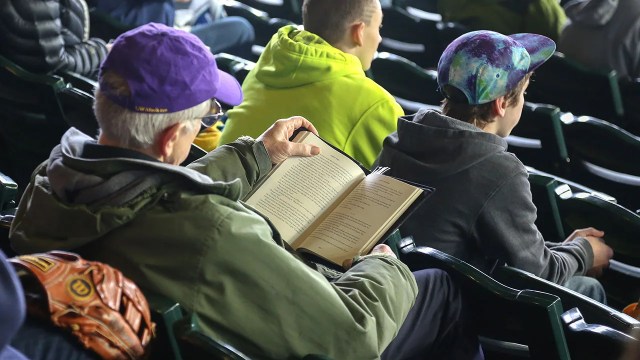
Roughly 115 million people watched the Super Bowl in 2023, making it the most widely viewed U.S.-based telecast in history. Large numbers of Americans also watch or attend college sports. In August, for example, more than 92,000 people attended an outdoor women’s volleyball match in Nebraska – breaking the attendance record for any women’s sporting event in the United States.
Yet for all the fanfare surrounding professional and college sports, most Americans do not closely follow or often talk about them, according to a new Pew Research Center survey.
Pew Research Center conducted this study to explore sports fandom in the United States and the reasons why Americans do or don’t follow sports.
This analysis is based on a survey of 11,945 U.S. adults conducted Aug. 7-27, 2023. Everyone who took part is a member of the Center’s American Trends Panel (ATP), an online survey panel that is recruited through national, random sampling of residential addresses. Address-based sampling ensures that nearly all U.S. adults have a chance of selection. The survey is weighted to be representative of the U.S. adult population by gender, race, ethnicity, partisan affiliation, education and other categories. Read more about the ATP’s methodology.
Here are the questions used for this analysis, along with responses, and the survey methodology.
About six-in-ten Americans (62%) say they follow professional or college sports not too or not at all closely. Another 21% say they follow sports somewhat closely, while just 16% follow them extremely or very closely, according to the August survey of 11,945 U.S. adults.
Sports also aren’t an especially frequent topic of conversation for most Americans – whether that’s in person, by text, online or some other way. Some 63% of U.S. adults say they talk about sports with other people a few times a month or less often. Another 26% say they talk about sports once a week or a few times a week, and 10% say they talk about sports once a day or several times a day.
Adults under 50, women and people in lower-income households are among the demographic groups most likely to say they follow sports not too or not at all closely. Women and those in lower-income households are also among the groups most likely to talk about sports less often than once a week.
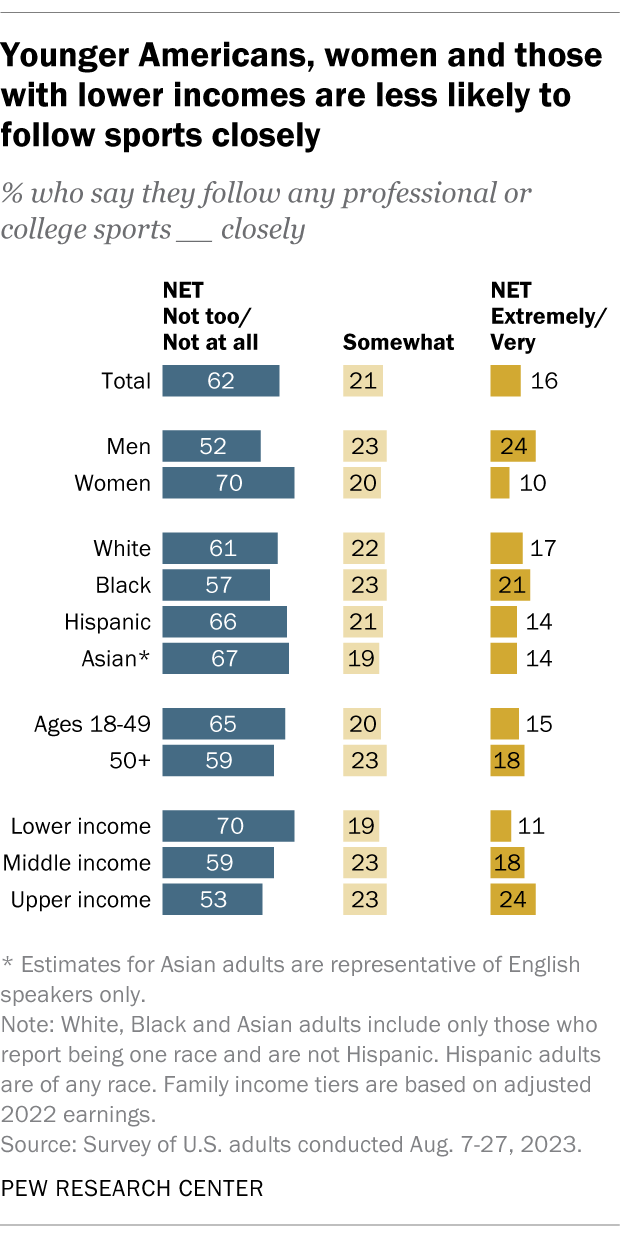
Among the other key takeaways from the survey:
- When asked how many sports they follow, the largest share of Americans (39%) say they don’t follow any sports. Smaller shares say they follow one (18%), two (22%), three (11%), or four or more sports (9%).
- By a large margin (51% vs. 5%), Americans believe sports get too much attention in society today, rather than too little, while 43% say they get about the right amount of attention.
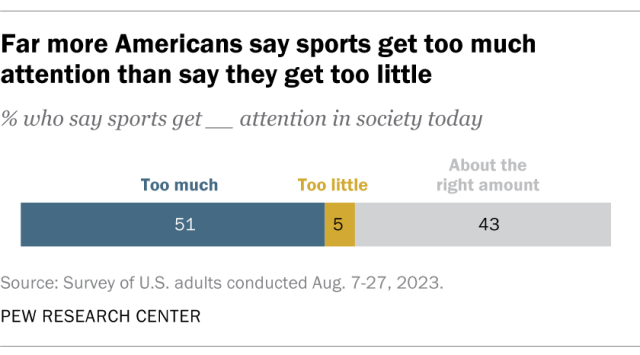
Why most Americans don’t closely follow sports
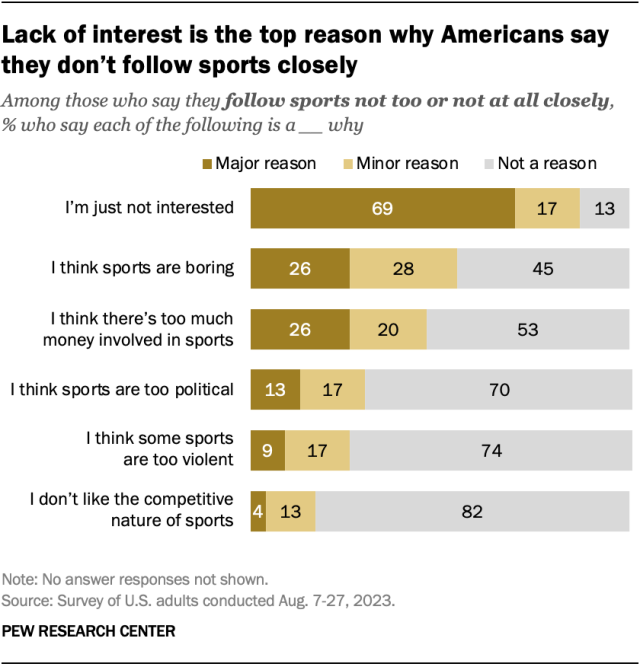
When given a list of possible reasons why they don’t follow sports, the most common one that people choose is lack of interest. About seven-in-ten adults who don’t closely follow sports (69%) say this is a major reason why. Another 17% cite this as a minor reason, while 13% say it’s not a reason.
The next-most common major reasons for not following sports closely – each cited by 26% – are that sports are boring and that there’s too much money involved in sports.
Just 13% of Americans who don’t follow sports closely say a major reason why is that sports are too political. Though people in both political parties are equally likely not to follow sports, Republicans and those who lean toward the Republican Party are more likely than Democrats and Democratic leaners to say this is a major reason why (22% vs. 5%).
Small shares also say that a major reason why they don’t closely follow sports is that some sports are too violent (9%) or that they don’t like the competitive nature of sports (4%).
There are some age differences in the reasons Americans cite for not following sports. Among those who don’t closely follow sports, adults ages 18 to 29 are more likely than those 65 and older to say they’re just not interested (76% vs. 65%) or that they find sports boring (35% vs. 21%). On the other hand, older adults who don’t closely follow sports are more likely than younger adults to say there is too much money in sports (by 22 percentage points), sports are too political (9 points), or some sports are too violent (8 points).
Why some Americans closely follow sports
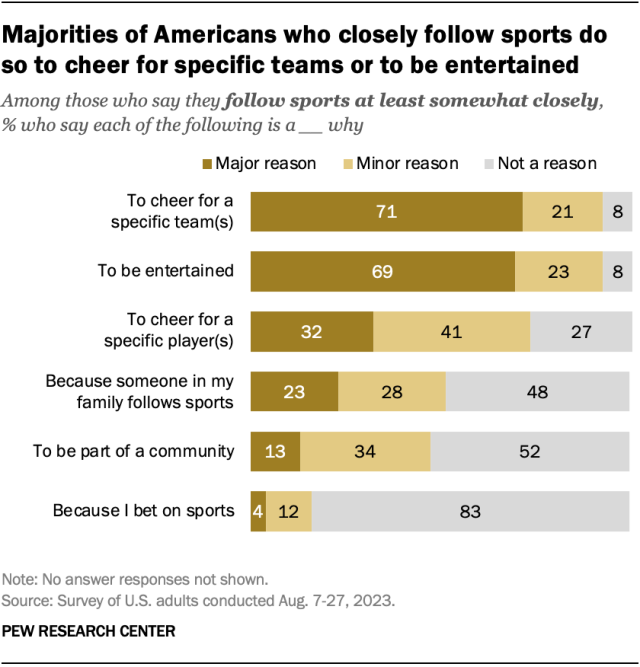
Among the smaller group of Americans who follow sports extremely, very or somewhat closely, 71% say a major reason why is to cheer for a specific team or teams. A similar share (69%) says a major reason is to be entertained.
Much smaller shares say a major reason why they follow sports is to cheer for specific players (32%), because someone in their family follows sports (23%), or to be part of a community (13%). Just 4% say a major reason is because they bet on sports. A separate Center survey from 2022 found that about one-in-five Americans had bet money on sports in the previous 12 months.
Again, some age differences emerge in the reasons people give for following sports.
Adults ages 18 to 29 are much more likely than those 65 and older to say a major reason they follow sports is because someone in their family does (38% vs. 16%). Younger adults are also 9 percentage points more likely than older adults to say they follow sports to cheer for specific players, but by the same margin, older adults are more likely than their younger counterparts to follow sports to cheer for specific teams.
Who are sports ‘superfans’?

A small subset of Americans are what might be called “superfans.” These fans say they follow sports extremely or very closely and talk about sports at least daily. Only 7% of U.S. adults fall into this category.
Men are about three times as likely as women to be superfans (10% vs. 3%), but there are no differences by age, race or ethnicity, or education level.
Superfans and more casual fans cite similar reasons for following sports. As is the case among more casual fans, the top two major reasons superfans cite for following sports are to cheer for a specific team or teams (84%) and to be entertained (84%). (Casual fans include those who follow sports at least somewhat closely but are not superfans.)
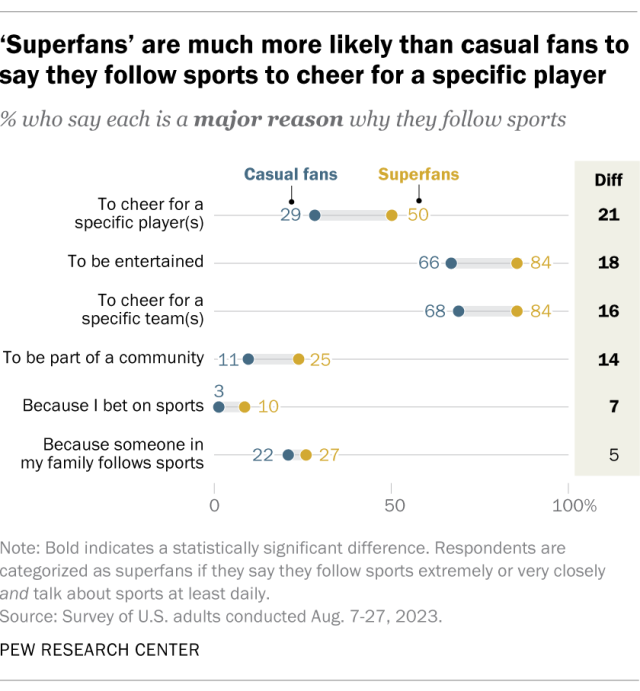
However, superfans are more likely than casual fans to cite nearly every reason asked about in the survey. The reason that produces the largest gap between superfans and casual fans is cheering for a specific player or players: Half of superfans cite this as a major reason why they follow sports, compared with about three-in-ten more casual fans (29%).
Note: Here are the questions used for this analysis, along with responses, and the survey methodology.
